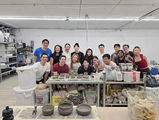Samsung Electronics
A 12-month UX design internship working on B2B enterprise device management and security solutions for Samsung Knox.
Timeline
May 2024 - April 2025
Contribution
Designed wireframes and high-fidelity mockups, created custom icons, conducted competitive research, built feature prototypes, developed research plans, and reviewed UI through QA testing and ticket submissions.
Tools
Figma, JIRA, UserTesting, Sketch
Internship story
The start of chaotic 12-months
In May 2024, I began my first UX Design internship at Samsung R&D in Vancouver. I joined during a time of transition—team reshuffles, a new office floor, and the start of a major release sprint. It was a fast-paced and slightly chaotic introduction, but also a valuable crash course in real-world product design. Despite the initial challenges, I quickly found my place on the UX team, contributing to Knox Manage, and supporting early efforts to introduce unmoderated usability testing tools into our workflow.
The product
What is Knox?
Samsung Knox is Samsung’s enterprise security and device management platform, designed to help businesses protect and manage their mobile devices, data, and apps. It offers a suite of B2B solutions that enable IT administrators to remotely configure, monitor, and secure both company-owned and employee devices

Illustration of Samsung Knox device security layers
Main project
Knox Manage
From the beginning of my internship, I worked closely with the Knox Manage team, collaborating with product managers in Korea and developers in India. Knox Manage is Samsung’s cloud-based Enterprise Mobility Management (EMM) solution that allows organizations to remotely manage, monitor, and secure employee devices—whether company-owned or personal.
One of the major initiatives was integrating the new Lite Console into the existing Knox Portal, where the current model, Knox Manage Advanced, operates as a standalone service. This project involved aligning with established UX patterns while modernizing outdated UI components and addressing long-standing user pain points. Knox Manage supports a wide range of IT admin features, from basic to advanced. This required us to carefully analyze and streamline user flows to ensure the experience remained intuitive for both new and experienced admins—all while staying competitive within the broader EMM space. Our design efforts contributed to Knox Manage receiving international UX recognition, including the UX Design Award 2025, iF Design Award 2025, and Red Dot Design Award 2024.
Knox Manage Interface – Co-designed for iF Design Awards 2025
My role and responsibilities:
As a UX Design Co-op, I gained hands-on experience across multiple stages of the product lifecycle from discovery and ideation to final delivery. Since I’m bound by the noble shackles of an NDA, I can’t share everything here, but I’d be happy to talk more about the specific tasks, features I worked on, and my design process. Just reach out and let’s chat!
Here are some of my key responsibilities:
UX design tickets
Collaborated with PMs to discuss JIRA ticket requirements, created wireframes and UX documentation that outlined design flows for senior designers and PMs to review before handoff to developers.
High-Fidelity GUIs
Designed pixel-perfect, developer-ready GUIs aligned with the Knox design system. Also created custom icons to support new features.
Competitive analysis:
Researched competitor UEMs to inform design decisions, identify feature gaps, and support team discussions to plan improvements.
Quality Assurance (QA)
Reviewed over 100 design tickets post-release to ensure visual and functional accuracy. Flagged inconsistencies by filing bug tickets in JIRA and worked closely with developers to resolve them.
Reflection
At the end of my journey
Designing through constraints
One of the key challenges of working in-house was navigating the balance between what UX aims to achieve, what product managers prioritize, and what developers can realistically build. At a large organization like Samsung, not every idea makes it into production due to tight timelines, technical limitations, or shifting business goals. Instead of stepping back when faced with constraints, I learned to advocate for design by clearly communicating its value and finding practical compromises. This often meant breaking solutions into phased releases or rethinking designs to be more intuitive and easier to implement, while still maintaining a strong user experience.
Clear and accessible deliverables
As students, we often design to ourselves, without needing to communicate with developers or product managers. In a real-world setting even the best design isn’t effective if it can’t be easily understood and implemented by others. I learned to anticipate questions, include developer-friendly notes, and structure my documentation in a way that supports both clarity and long-term usability. Well-organized, thoughtful files not only reduce confusion but also ensure others can build on your work after handoff.
Moments with the incredible UX team who made this journey unforgettable












